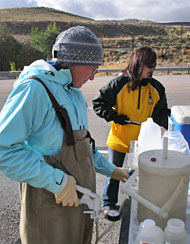|
|
Water quality is measured using an instrument called a sonde, which means "probe" in French. The sonde is an electronic device that contains up to five different sensors that measure the water quality constituents described below. Measurements are made every hour and recorded using a field computer called a data logger. The data logger is linked to an office computer using either telephone or radio. A photovoltaic panel provides electrical power to the monitoring station. (Abbreviations for the constituents are given in parentheses.)
Temperature (Temp)
is a measure of the amount of heat present in water. Aside from dissolved oxygen, temperature is considered the single most important constituent influencing aquatic life. Knowledge of water temperature is essential to the measurement of dissolved oxygen, conductivity (salinity), pH.
Dissolved oxygen (DO)
is the measure of the amount of oxygen present in water and available for respiration. D.O. is measured in milligrams per liter as well as in percent saturation. Oxygen is less soluble in warm and salty waters, so the instrument compensates the apparent percent saturation for changes in temperature and conductivity. The probe measures the current resulting from the electrochemical reduction of oxygen (at a gold cathode) diffusing through a selective membrane. In areas with submerged aquatic plants, the D.O. increases during the day due to photosynthesis. Nighttime decreases in D.O. are a result of respiration by the aquatic vegetation and other sources of oxygen demand.
pH
is a measure of the degree of the acidity or the alkalinity of a solution as measured on a scale ("pH scale") of 0 to 14. pH measures the hydrogen ion activity of a system: below pH 7 is acidic; pH 7 is neutral; above pH 7 is alkaline (or basic). pH is a major factor affecting the availability of nutrients to plants and animals. A pH probe consists of an ion selective glass membrane, whose electrical potential is measured with respect to a reference electrode.
Conductance/specific conductance (SPC)
is a measure of the ability of water to pass an electrical current, which increases with the amount of dissolved ionic solids (i.e., salts) that the water contains, and therefore provides a measure of total dissolved solids (TDS). Conductivity is inversely related to the resistance of a solution, and is measured in units of mhos/cm (Siemens/cm). The conductivity of water increases with increasing temperature; so the readings are adjusted to a standardized temperature, 25 degrees C, and reported as Specific Conductance. The conductance probe measures the current between two electrodes held at a fixed potential.
Turbidity (Turb)
is a measure of the murkiness of water, the opposite of water clarity, and is measured in NTUs (Nephelometric Turbidity Units). Particles in water cause light to be scattered and absorbed rather than transmitted in straight lines through a sample. The probe measures the intensity of infrared light scattered at 90 degrees from the incident beam. Because suspended sediment is a primary source of turbid water, turbidity can be calibrated at a specific site to provide an indirect measure of suspended material. In the Portneuf River, turbidity also serves as an approximate measure of total phosphorus concentration.
|

Amanda Rugenski and Melissa Thompson process samples collected from the churn splitter.
|

